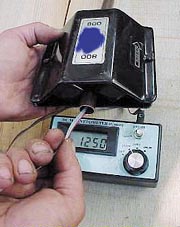
The subject of anti-scale magnetic treatment (AMT) and other physical methods of scale suppression remain controversial and still are labeled as gadgetry in some scientific circles. The debate is understandable; for many years the positive effects well documented in trade literature have been undermined by the apparent lack of good results from laboratory tests. In addition, some manufacturers continue to promote ineffective devices (with dubious literature) for applications where no real evidence exists ? anecdotal or otherwise ? to show that they could ever, or have ever worked. However, many devices on the market have reasonably good track records, but even these have occasionally proven ineffective in certain situations.
Many designs of commercial magnetic treatment devices (MTDs) for water are available; some use electromagnets while others use single or arrays of permanent magnets. Other MTDs are clamped onto the pipe, but these typically display lower field strengths than the plumbed-in variety. Other physical conditioners generate electric fields or alternating radio frequency and often claim to be more effective that MTDs, but there is no hard evidence to substantiate this. Still other conditioners subject the flowing water to an electrostatic charge between two or more electrodes.
Upon reviewing available literature, the School of Water Sciences at Cranfield University in England arrived at the conclusion that most reported successful applications of MTDs have occurred in continuously recirculating systems enabling repeated treatment of the process water. The viability of AMT in certain applications can be emphasized by looking at the sales of CEPI-Co, Belgium, one of Europe's longest established manufacturers that has sold in excess of 700,000 units worldwide. In these instances, operators often describe an accumulation of sedimented scale in low-flow areas of the system and formation of a softer, less tenacious scale. Encrusted scale also has been removed over periods of three to six months. It is fairly well agreed that the anti-scale effect results from changes in crystallization behavior promoting bulk solution precipitation rather than formation of adherent scale. The magnetic effect also appears to be enhanced under conditions of supersaturation and a high ionic load of the process water. Credible laboratory studies have detailed increased solution precipitation rates, crystal size and morphology changes, enhanced and retarded coagulation and a retention of the anti-scaling properties of the water for hours or days following treatment. In many of these studies, the results have only been apparent under dynamic magnetic treatment (the solution moving sufficiently rapidly through the field).
Many mechanisms for the anti-scaling effect have been proposed, some clearly ill-informed such as magnetically induced changes in electron configuration. None, however, are fully comprehensive and can account for all of the observed effects. Early Russian work, which claimed changes in the structure of water resulted from magnetic exposure, has largely been disproved by subsequent work. Other Russian scientists have more recently proposed models to support the theory of enhanced nucleation in the bulk solution. However, other European experts have concluded that that theory unlikely is valid.
Others believe that the reason for the soft scale so often described results solely from magnetically induced changes in crystal habit, however, this also is unlikely since many other factors (specifically the presence of contaminants, heat or pressure) influence the preferred crystallizing form of calcium carbonate. Another school of thought involves the influence of contaminants introduced by magnetically induced corrosion or by slow release from the MTD. One thing is for sure ? there is an interaction between a magnetic field and crystallizing matter, which can, on occasions, affect its scaling behavior. As engineers, we are primarily interested in deducing a satisfactory design basis and the conditions under which the process will repeatedly work. As scientists, we want to know how it works.
The lack of a comprehensive mechanism was demonstrated by a recent seminar at Cranfield University which invited leading researchers from Europe, South Africa, Japan and the United States to present current scientific progress on the understanding of AMT. Various views were represented.
Some researchers claim that the main effect could be on surfaces present in the system. Another has investigated links between zinc release from MTDs and has found a positive correlation between the rate of zinc release and the effectiveness of the device. Other research conducted indicates a credible mechanism based upon the solid scientific principles of electromagnetic induction and magnetohydrodynamics, promoting either corrosion and/or precipitation, or even orthokinetic flocculation when a conducting solution is made to flow through a magnetic field.
What is needed is a complete analysis of all instances where AMT has worked effectively and, more importantly, where it has not. In this way, it may be possible to deduce which factors are crucial in terms of a successful application. In addition, it can be seen that real results are realized after periods of months whereas most laboratory studies have tried to achieve results after hours or days using accelerated scaling techniques. A recent article compares AMT to biological enhanced phosphorous removal from sewage in that it was developed and used by engineers long before a microbiological rationale was suggested. Whatever the outcome of the debate, the benefits of non-chemical water treatment are obvious, from both economic and an environmental points of view.

Magnetic Water Treatment - An Overview
The build-up of scale deposits is a common and costly problem in many processes using natural water supplies. Scale formation is the precipitation of sparingly soluble salts, most commonly calcium carbonate, which form an encrustation on susceptible surfaces. Most commonly, this occurs as a result of temperature or pH changes, influencing the solubility of the scale former. Other common scale-forming compounds include calcium sulfate, barium sulfate, calcium phosphate, magnesium hydroxide, zinc phosphate, iron hydroxides and silica, all of which naturally occur in raw water supplies.Traditional chemical methods of scale control or water softening involve either the pre-precipitation of the scale former with lime or soda ash, the addition of scale-inhibiting reagents or the replacement of the scale former with soluble ions by ion exchange. All of these methods, though effective in scale control, substantially change the solution chemistry and can be prohibitively expensive.
Anti-scale magnetic treatment (AMT) has a long and controversial history and has been reported as being effective in numerous instances. Its effect is to either reduce scale deposition, remove existing scale or produce a softer and less tenacious scale. Many reports claim large savings in energy, cleaning (i.e. de-scaling) and process downtime costs from the installation of magnetic water conditioners in real systems. However, installed MTDs also have often proved ineffective in real installations though the precise reasons for their inefficiency are rarely examined in such cases.
Reported effects of magnetic conditioning of water have appeared in the literature since the late 1930s. These usually have related to AMT, though there is some evidence that magnetism interacts directly with microorganisms. Reported effects appear to vary widely, possibly reflecting variations in water quality, and the apparent lack of their reproducibility has tended to undermine the credibility of the process. The paucity of systematic studies of the phenomenon, independent of AMT device manufacturers, and the lack of recorded design criteria have prevented acceptance of the method by process designers and plant engineers. The scientific literature still is unable to explain confidently why AMT works in some applications and not in others. Recent research at Cranfield University in England has identified conditions under which magnetic treatment can lead to a maximum of 70 percent reduction in calcium carbonate scale formation. The degree to which scale formation is inhibited has been identified to be dependent on a number of physiochemical conditions, such as temperature, pH, hardness and alkalinity.
Report Abusive Comment